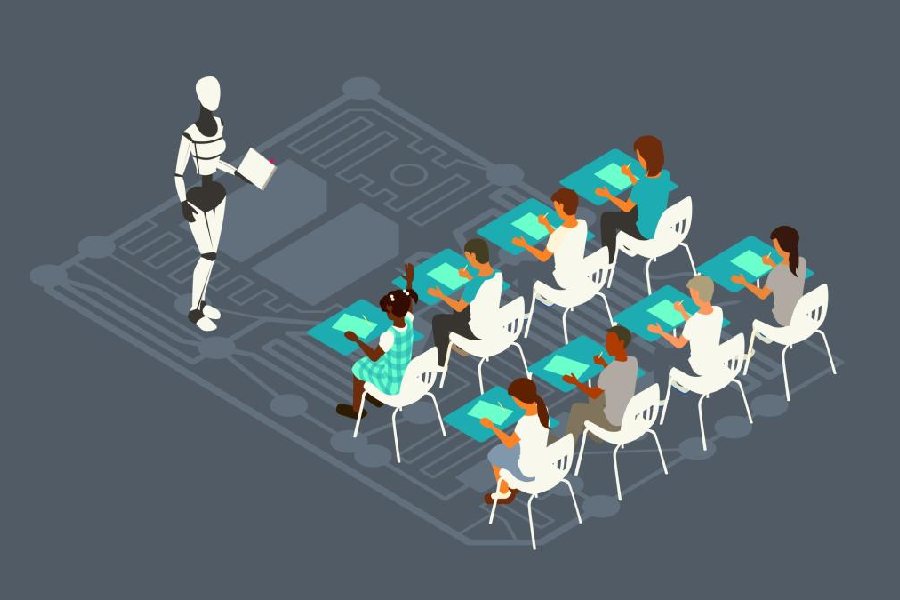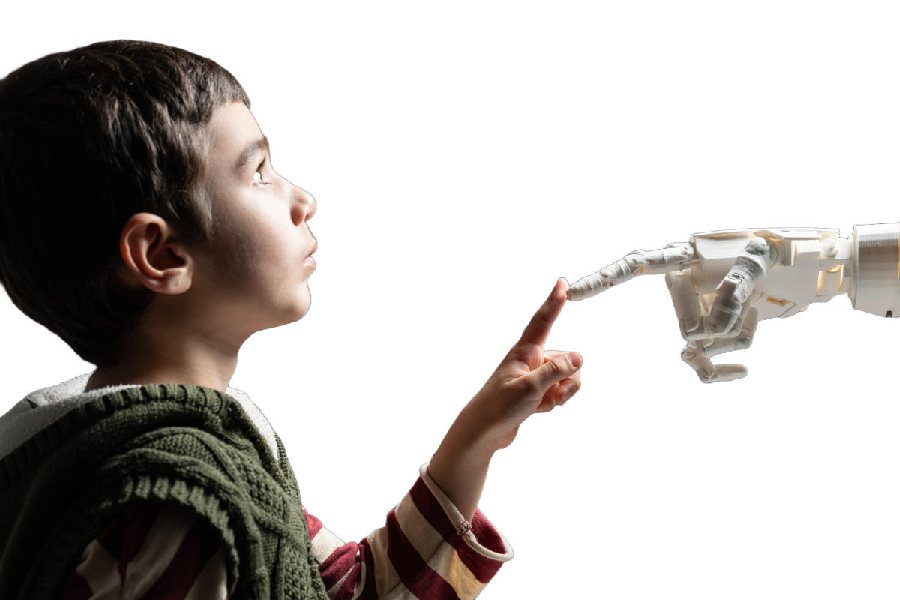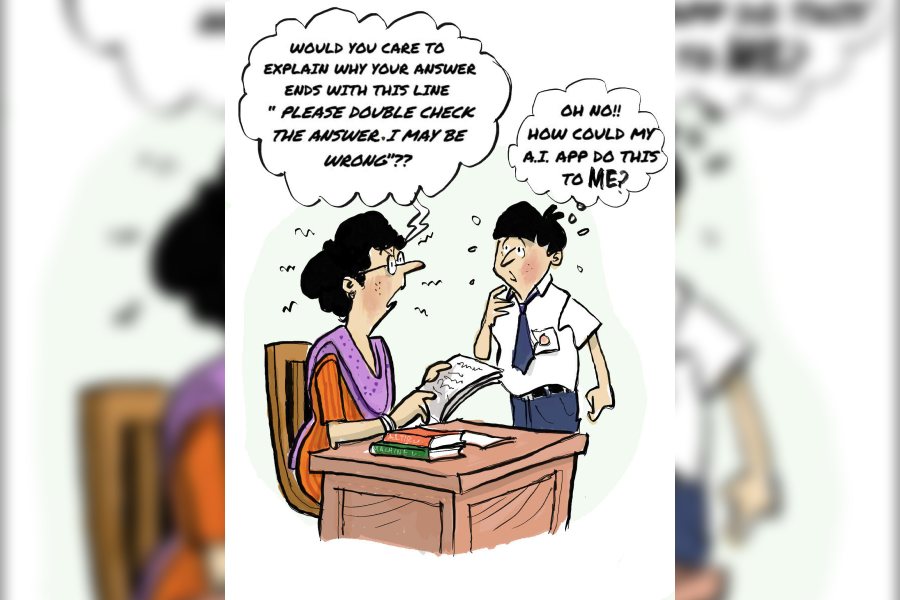Is your son’s essay reading like a Shashi Tharoor speech? Did your daughter complete her math homework in seconds? Has your child’s concentration suddenly hit the roof or is he, in the first week of April, making a fool of you?
Teachers are currently on their guard as many a student has been using AI chatbots like ChatGPT and Gemini to do their projects and homework. These are artificial intelligence (AI) language models that mimic human conversation and so are very simple to use. They are several notches above search engines like Google and can provide direct answers to homework, write a letter, plan a holiday, make PowerPoint presentations, and much more.
If used correctly, these chatbots can be great learning tools but students may be tempted to misuse them. Haryana Vidya Mandir (HVM) recently hosted a workshop for teachers on AI, conducted by EduMorphosis.
“AI tools can provide the latest information and at lightening speed, which one would have to search manually in books,” says Jharna Das, physics teacher at HVM, after attending the session. “Students are smarter than us at using technology so we have to keep up through such workshops.”
The school’s computer science teacher Tinny Bhattacharjee was acquainted with AI beforehand as it forms part of the syllabus for high school students. “But even outside the theory, it can be an innovative teaching aid and we must embrace the technology,” she says adding, however, that at times students hand in projects well beyond the abilities of teenagers. “They won’t admit it but it’s clear that they’ve used ChatGPT for it.”
Caught in the act
“When a student who can barely speak a sentence without confusing ‘have’ and ‘has’ churns out answers in impeccable English, you know something’s amiss,” says Anirban RoyChoudhury, a school and college-level finance teacher from CD Block.
“Whenever I suspect something like this, I ask the student to answer verbally or explain the steps he has taken in solving sums. And then they confess having copied it all off ChatGPT,” RoyChoudhury says.

A robot teacher leads a class of eight children sitting in elementary school desks, illustrating the concept of AI-powered education
Sangeeta Ray, who teaches English, geography, and social science at her DB Block home, caught a student freeloading off ChatGPT and then had a frank word with them all about the perils of delegating homework to AI. “I never had anyone else do it after that but one of my students says all his classmates use this for homework. The teachers in that school are asked to be lenient by the management and so look the other way. And their parents cannot monitor the situation as they themselves don’t know what ChatGPT is,” she says.
Projects and presentations
Juliana Shukla, academic advisor of Salt Lake Point School, admits many students had started handing in projects verbatim. “This practice of dishonesty started with online tests during the pandemic and ChatGPT has taken it to the next level. We ask students to re-do their projects if we catch them,” she says.
College students are misusing the chatbots too. “At our Model United Nations meet last year, two or three ‘nations’ were disqualified as the judges found their speeches to be heavily lifted from AI chatbots,” says Rajsekhar Hajrah, an engineering student at IEM, who was volunteering at the event.
What is the harm?
If used as a learning – instead of cheating – tool, these bots can be a boon. “If students can learn more with these bots, what’s the harm?” asks Anthony Das, principal of Sri Aurobindo Institute of Education and father of a teenager who uses ChatGPT for project ideas. “Our school had, in fact, invited experts from IIT Kharagpur to introduce our students to this technology so they can make the best use of it.”
RoyChoudhury says there’s nothing to hide from students. “Some students benefit by going through AI first and then referring to books in a form of backward learning,” he says, although adding that sometimes, these bots can be completely wrong in giving numerical answers. “And teachers have to be well-versant with the technology so as to not get outsmarted by youths.”

If used as a learning – instead of cheating – tool, these bots can be a boon.
This is why Shukla made it a point to attend a conference on AI and robotics held at Narayana School a while back. “I don’t use the bots regularly but I know what it’s capable of and how students may use and misuse it,” she says.
Live and let live
Prosenjit Gupta, an algorithms professional, asks us not to wish AI chatbots away. “This is an important revolution and global institutes are now allowing students to use the likes of ChatGPT so long as they acknowledge it as a source in their papers,” says the Sanjeeva Town resident who runs the teaching start-up Elahe Technologies. “I too allow my students to use them.”
Gupta, however, does not allow his 15-year-old daughter to use ChatGPT. “At her age, it would create a dependency. This is why, despite its benefits for advanced learners, calculators are discouraged among young students. My daughter has, however, attended generative AI courses to create music. Teachers at her school in New Town have never mentioned ChatGPT but ask students not to copy answers off Google,” he says.
Teachers using it too
While several teachers and principals The Telegraph Salt Lake spoke to were not sure of what ChatGPT was, some institutes have made it mandatory for faculty to learn it.
“We’ve conducted workshops on these for our faculty,” says Dipankar Bhattacharya, principal of Techno Main Saltlake. “AI can save precious time that would otherwise be spent doing clerical work. For instance, we no longer write minutes of meetings; we just feed the points and AI fleshes it out. If we need a letter written for a student’s poor attendance, AI does the same. It can create pictures, PowerPoint presentations... Refusing to embrace this technology is like refusing to use a car because walking is good exercise.”
RoyChoudhury finds ChatGPT useful in setting multiple-choice question papers. “It otherwise takes too long to cook up four likely choices for so many papers and so many classes,” says the teacher who is himself pursuing a PhD. There, however, the bots have limited scope. “PhD work is research in a field where there exists an information gap. Chatbots can only point to a general direction here,” he says.
He concedes, however, that it is quite difficult to detect AI-generated content. “I have long used anti-plagiarism software like Turnitin. These analyse a student’s write-up and give a similarity report that represents the portion of his work that matches existing online data. A score of up to 15 per cent is acceptable. But these softwares are unable to detect ChatGPT’s work.”
Bhattacharya agrees. “To further remove suspicion from the teacher’s mind, students can always ask ChatGPT to intentionally include a few grammatical mistakes in its answer,” he offers. “We are encouraging students to learn AI tools but asking them not to become slaves to it. Write what you can and ask the bot to polish it up,” he says.
Human teacher or bot
Devansh Bose, a Class VIII student of Delhi Public School Newtown, learnt Chat GPT and Gemini from YouTube and now uses them to make timetables and get math problems explained.
“In some ways ChatGPT is more effective than a human teacher as it can generate images to explain difficult concepts. Sometimes, if I miss an explanation in class or if a doubt remains even after the teacher’s explanation, I know I can always go home and ask my digital assistant,” says the CD Block resident. He also uploads pictures of his chapters and asks the bots to summarise them. “For tests, we need to read the entire chapter but a summary helps in revision.”
Rajsekhar, the engineering student, says the bots help him immensely while coding. “It corrects errors just like a face-to-face teacher would,” says the CK Block resident who also imparts tuition to school students. “But AI is no substitute for human teachers. A bot is limited by the information we feed it, whereas a human teacher can evaluate us holistically to nurture our strengths and address our weaknesses.”
Indrani Banerjee, English teacher at St Francis Xavier, says she has had in-depth discussions on the issue with her students. “The ISC Class XI syllabus has a Roald Dahl story called The Great Automatic Grammatizator. It’s about a machine that can write amazing stories at great speed, bringing its inventor much financial success,” Banerjee says.
“Though written in the last century, Dahl pretty much explains Chat GPT before its advent. In our discussions, I’ve asked students to stay away from it at this stage of learning. That way they can develop their own imagination and creativity while turning to AI later on,” Banerjee says.
